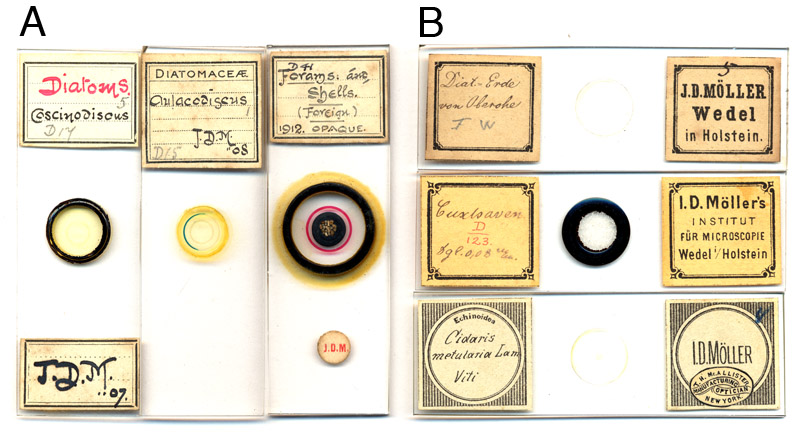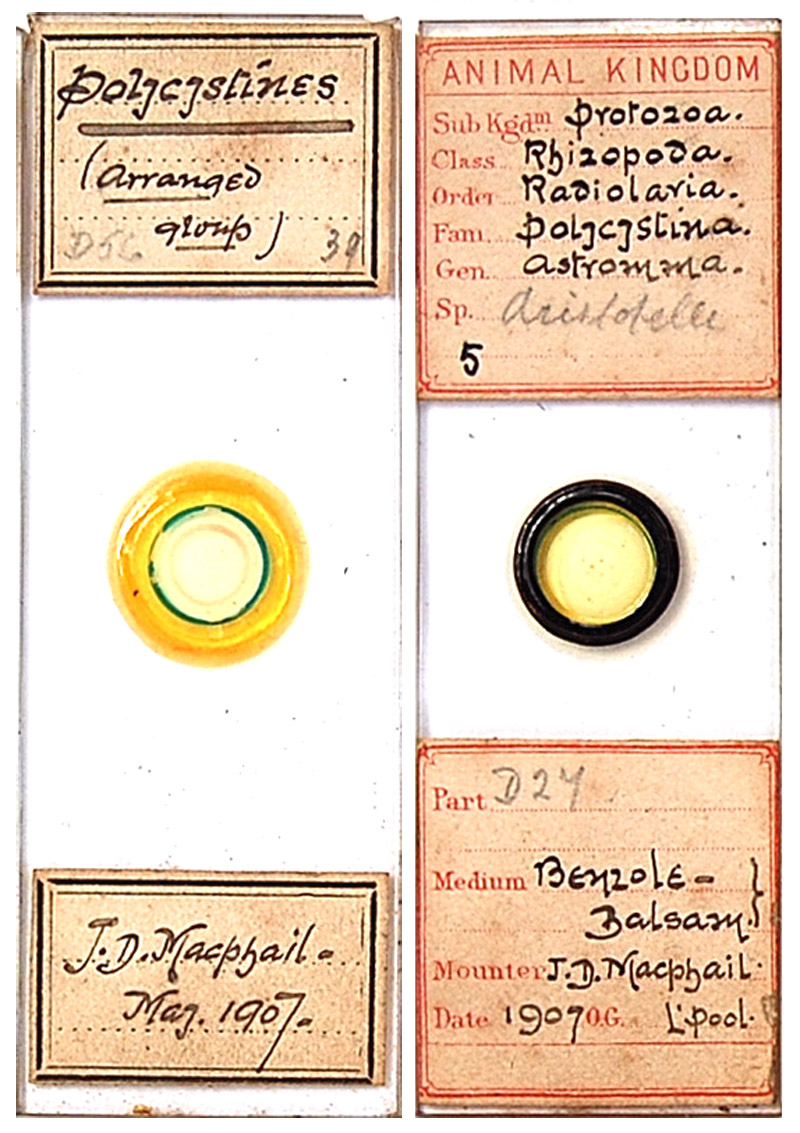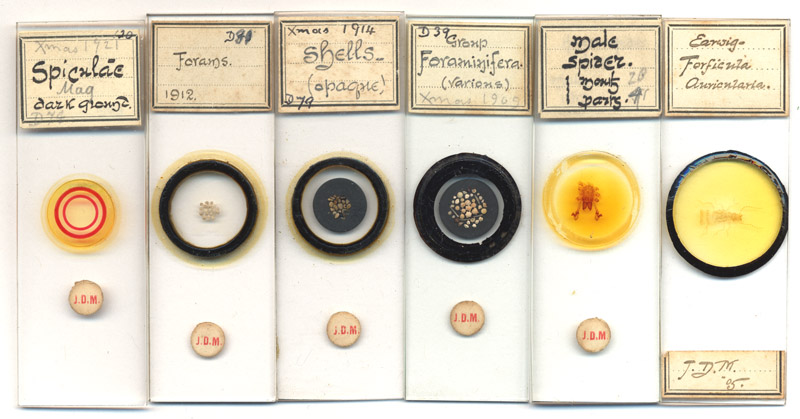
James Doke Macphail, 1860-1931
by Brian Stevenson, Kentucky, USA
Antique microscope slides are occasionally encountered that bear hand-written labels and the initials “J.D.M.” (Figure 1A). Such slides are often attributed to Johann D. Möller, the famous mounter of diatoms (Figure 1B). However, there are numerous inconsistencies with that assumption. Möller used neat, printed labels for his slides, whereas J.D.M. used off-the-shelf labels. Möller’s handwriting was very different from that of J.D.M. Being German, Möller generally wrote in that language, while J.D.M. wrote exclusively in English. Finally, Johann Möller died in 1907, while many J.D.M. slides bear dates later than that. Two recently discovered microscope slides have solved the enigma of J.D.M., and conclusively identify that the maker was actually James D. Macphail (Figure 2).

Figure 1. Examples of microscope slides made by “J.D.M.” (panel A) and Johann D. Möller (panel B).

Figure 2. Microscope slides labeled J. D. Macphail
James Doke Macphail was born during 1860 in Stepney, Middlesex. He was the eldest of two children of William, a cooper, and Emma Macphail. Sister Emma was born one and a half years later, after the family had moved to Lancashire. The 1881 census recorded James as being a clerk for a “friendly society”, while the 1891 census listed him as a “book keeper”. During the summer of 1897, James married Marguerite Sidders in London, her home town. The 1901 census recorded 41year-old James and 55 year-old Marguerite living at 40 Moss Lane, Walton-on-the-Hill, Lancashire, with James’ widowed mother and two servants. James was then a building society manager. Marguerite died in early 1920, and James remarried that summer, to Gertrude M. Thomas.
James Macphail was a long-time, active member of the Liverpool Microscopical Society, joining in 1898. He served as the Society’s President in 1905, 1906, 1914 and 1915. His first inaugural address was entitled “The Draughtsman’s Art in Relation to Biological Science”, and his second was “Commercialism and Science”. James was also a member of the Council numerous times. Macphail delivered many presentations to the Society, including “The Morphology of the Radiolaria” in 1908, and “Diatoms” in 1909. Among slides he exhibited were “Dalton’s exhibition slides of butterfly scales”, “various parasites”, “pond life”, “West Indian sponges” and “fern sori” in 1909 and “slides showing structures of tsetse fly” in 1920.
Wife Gertrude joined the Liverpool Microscopical Society in 1921.
James D. Macphail died in 1931, at the age of 71. His books, described as being “especially strong in natural history” were sold by William C. Elly, Liverpool, in 1933.
Although J.D.M. was not J. D. Möller, his slides are generally of high quality, and should be welcome in any antique microscopy collection. Macphail’s arranged diatoms, spicules, etc. were intricately placed in geometric patterns. He was clearly an excellent, amateur microscopist.

Figure 3. Additional microscope slides by James D. Macphail, including arranged sponge spicules, diatoms and foraminifera, and balsam mounts of a spider and an earwig. The specimens in Macphail’s arranged slides are often meticulously arranged in geometrical patterns, indicating the maker’s considerable mounting skills.
Comments to the author will be welcomed.
Author’s Note
This and other biographies of historical microscopists can also be seen at http://microscopist.net
Acknowledgements
My thanks to Robert Smith for providing the images of J.D. Macphail autographed slides.
Resources
Bracegirdle, Brian (1998) Microscopical Mounts and Mounters, Quekett Microscopical Club, London
British Books (1933)
England vital statistics, accessed through ancestry.co.uk
Report of the Liverpool Microscopical Society (1887-1924, not inclusive), accessed through www.archive.org/details/reportofliverpoo18live
Microscopy UK Front
Page
Micscape
Magazine
Article
Library
Published in the August 2010 edition of Micscape Magazine.
Please report any Web problems or offer general comments to the Micscape Editor .
Micscape is the on-line monthly magazine of the Microscopy UK website at Microscopy-UK .
© Onview.net Ltd, Microscopy-UK, and all contributors 1995 onwards. All rights reserved. Main site is at www.microscopy-uk.org.uk .